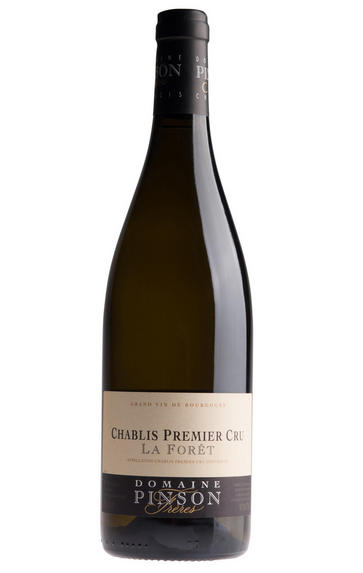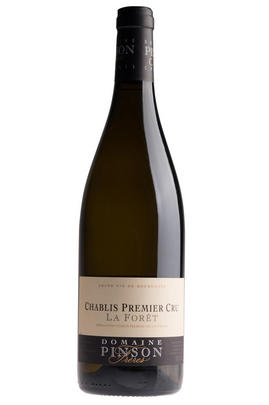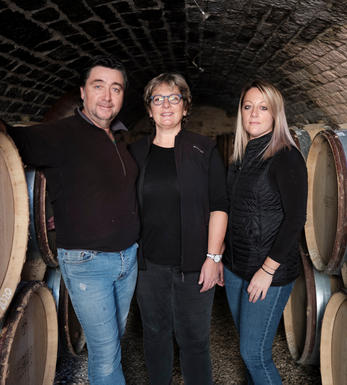
2012 Chablis, La Forêt, 1er Cru, Domaine Pinson Frères, Burgundy

Critics reviews
Alan Meadows - Burghound - 0ct-15-2013
Neal Martin - 30/10/2015
About this WINE

Domaine Pinson
The Pinson family have been growing grapes and making wine since 1640. They were among the first in Chablis to bottle their wines for public sale, in the 1880s. By 2009, the area under vine had grown to about 14 hectares, with holdings in Grand Cru, Premier Cru and village-level Chablis vineyards. The wines are made in the classic Chablis style while expressing the distinctive character of each terroir.
Domaine Pinson Frères has a fine range of vineyard sites, including four parcels in the Grand Cru Les Clos from which they make two different cuvées, and which allows them to combine the best features of the site.
The frères in the name are brothers Laurent and Christophe Pinson. Laurent's daughter Charlène has been winemaker here 2008, arriving with a degree in viticulture-and-winemaking from Beaune, and experience working in the Rhône. She has retained the traditions that have served the domaine well, using small amounts of new oak and mostly stainless steel, and has also introduced improvements in the cuverie, such as smaller tanks for more precise blending.
The domaine’s 14 hectares include holdings in Grand Cru (Les Clos), Premier Cru (Forêts, Fourchaume, Vaillons, Mont de Milieu, Montmains and Vaugiraut) and about two hectares of village Chablis. The estate’s plots on the left bank of the Serein River have Kimmeridgian soils rich in marine calcium and marl. On the right bank, soils are rich in calcium but with more clay, favouring a slightly richer style of wine. No weedkillers or insecticides are used, and yields are strictly controlled.
The Grand Cru and Premier Cru wines are fermented in 10-20% new oak, with the balance in stainless steel, and matured in older oak barrels. The village-level Chablis is fermented and aged entirely in stainless steel.

Chablis
Chablis lies further north than the rest of Burgundy, located about halfway between Beaune and Paris; it’s actually not all that far from Champagne. The wines here – exclusively whites from Chardonnay – differ in style from other white Burgundies: they tend towards steeliness and flintiness.
The Chablis region is an island of vines lying amid the forests and pastures of the Yonne département. In the heart of Chablis, the soils are marl (clay-limestone) of a particular kind – Kimmeridgian – containing traces of marine fossils. For many, the classic aroma and flavour profile of Chablis is built around seashell and an iodine, marine character imparted by the soil.
As elsewhere in Burgundy, there’s a hierarchy in Chablis. Grand Cru represents the top tier, although it accounts for just one per cent of overall Chablis production. The Grand Cru vineyards rise above the eponymous town in an impressive sweep, sloping south. These are sunny sites, ranging in elevation from 100 to 250 metres above sea level. The wines are deep and powerful, benefitting hugely from bottle age after release. The best examples can age for up to 20 years. Over time, their colour evolves from greenish gold to a light yellow, and they develop real aromatic complexity.
Unlike the other tiers, it’s not uncommon for Grand Cru Chablis to see new oak. As a result, its flavour profile is perhaps more comparable to the Côte d’Or than the rest of Chablis. For something more classically “Chablis”, there’s the Premiers Crus. Style and quality can vary, depending on the climat and the producer. Whether floral or more mineral, the best examples are seriously impressive and represent the hallmark style of the region – they can also offer real value for money. These are structured wines with the capacity to age for 10 to 15 years.
The next tier – accounting for most of the region’s output – is labelled simply as “Chablis”. These are steely, clean and lean whites with aromas of green apples and lemon, intended for early drinking. As ever in Burgundy, there are exceptions: well-made examples by top growers from vineyards abutting the Premiers Crus can be age-worthy.
Finally, there’s Petit Chablis: everyday wines, generally from vineyards planted on higher slopes. Petit Chablis accounts for around one-fifth of all Chablis produced. These wines typically come from Portlandian limestone, known to produce a fruitier, simpler wine than Chablis.

Chardonnay
Chardonnay is often seen as the king of white wine grapes and one of the most widely planted in the world It is suited to a wide variety of soils, though it excels in soils with a high limestone content as found in Champagne, Chablis, and the Côte D`Or.
Burgundy is Chardonnay's spiritual home and the best White Burgundies are dry, rich, honeyed wines with marvellous poise, elegance and balance. They are unquestionably the finest dry white wines in the world. Chardonnay plays a crucial role in the Champagne blend, providing structure and finesse, and is the sole grape in Blanc de Blancs.
It is quantitatively important in California and Australia, is widely planted in Chile and South Africa, and is the second most widely planted grape in New Zealand. In warm climates Chardonnay has a tendency to develop very high sugar levels during the final stages of ripening and this can occur at the expense of acidity. Late picking is a common problem and can result in blowsy and flabby wines that lack structure and definition.
Recently in the New World, we have seen a move towards more elegant, better- balanced and less oak-driven Chardonnays, and this is to be welcomed.


Buying options
Add to wishlist
Description
We appreciate this cuvée more every year, and while it is still too early for the nose to show much detail, this is clearly a very classy wine, with brilliant austerity and exceptional persistence.
Jasper Morris MW - Burgundy Wine Director
This long-established family domaine impresses us more and more with every vintage. The Pinsons have always picked by hand and they are now using natural yeasts for the vinification process. Most wines are vinified in stainless steel, with a small percentage in barrel for the top wines, then matured in barrel for up to a year. The only bad news in 2012 is the quantity: 20% down for straight Chablis, 25-30% less across the Premier Cru vineyards and minus 50% on the Grand Cru which was affected by frost.
wine at a glance
Delivery and quality guarantee